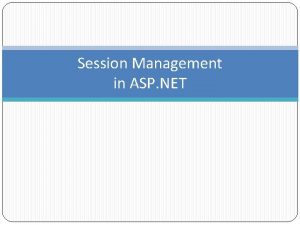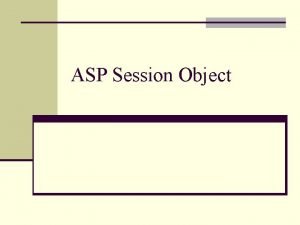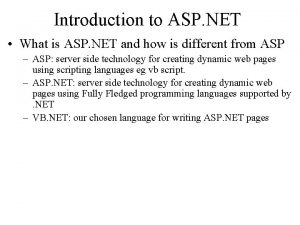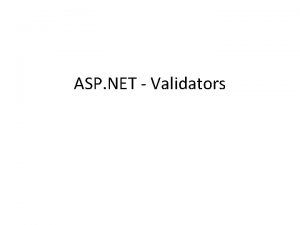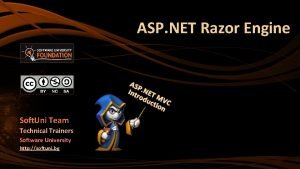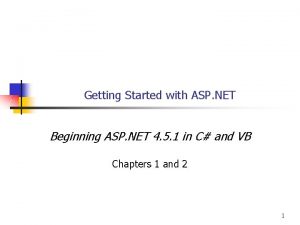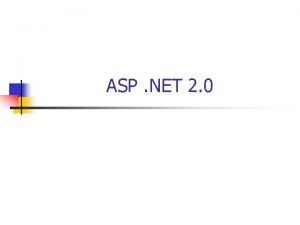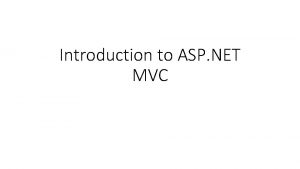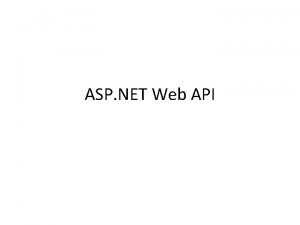Handling Session Classes for Predicting ASP NET Performance






















- Slides: 22

Handling Session Classes for Predicting ASP. NET Performance Metrics Ágnes Bogárdi-Mészöly, Tihamér Levendovszky, Hassan Charaf Budapest University of Technology and Economics, Hungary Department of Automation and Applied Informatics

Outline Introduction l Backgrounds l Ø Queueing model of web applications l Model demonstration and validation in ASP. NET environment Ø Model parameters estimation based on one measurement Ø Model evaluation with the help of MATLAB Ø Model validation l Conclusions and future work

Introduction Web-based information systems l An important factor: performance l Ø Low response time Ø High availability Ø Certain level of throughput l Properly designed performance model Ø Performance prediction Ø At early stages of the development process l Prominent technology: Microsoft. NET

Queueing Model of Web Applications 1 l Application – network of M queues Ø Application tier – queue with processor sharing discipline Ø A request can take multiple visits to each queue – transitions to its successor and its predecessor l Session-based workload – infinite server queueing system Ø Active session – occupying one server

Queueing Model of Web Applications 2

Evaluation algorithm l Mean-Value Analysis (MVA) Ø Recursive algorithm Ø Introduce customers one by one Ø Terminate when all customers have been entered Ø Visit numbers instead of transition probabilities l Utilization law Ø Utilization of the queues

Multiple session classes l Model enhancement: Ø Incoming sessions classified into multiple classes Ø Service times, visit ratios, user think time on a per-class basis Time and space complexities of MVA ~ number of feasible population l Approximate MVA algorithm in a few steps l Balanced job bounds in one step l

Model demonstration l Three-tier ASP. NET test web application

Model parameters estimation and model evaluation Each page and class belonging to the presentation, business logic or database were measured separately l Based on one measurement l Number of customers Max. number of customers Number of tiers Average user think time Visit numbers Average service times MVA Approximate MVA Balanced job bounds Response time Throughput Tier utilization

Experimental configuration 1 l Application Center Test Ø Warm-up time for the load to reach a steady-state Ø Sleep times to simulate realistic usage of the application Ø When we handle one session class, the number of simultaneous browser connections varied. Ø When we handle multiple session classes, there were two classes: a database reader and a database writer. The number of session of one class was constant 10, while the number of simultaneous browser connections of the other class was varied. Ø Average response time and throughput were measured.

Experimental configuration 2 Ø Observed response times and throughputs

Model validation – one session class 1 l Performance prediction with MVA algorithm Ø Model predicts the response time and the throughput acceptably

Model validation - one session class 2 Ø Utilization presentation tier is the first that becomes congested o database queue is the second (29%) o business logic queue is the last one (17%) o

Model validation - one session class 3 l Performance prediction with balanced job bounds Ø Model predicts the response time and the throughput acceptably

Model validation - one session class 4 Ø Utilization o presentation tier is the first that becomes congested o database queue is the second o business logic queue is the last one

Model validation – two session classes 1 l Performance prediction with approximate MVA algorithm Ø Model predicts the response time and the throughput acceptably

Model validation – two session classes 2 Ø Utilization presentation tier is the first that becomes congested o database queue is the second (76%) o business logic queue is the last one (15%) o

Model validation – two session classes 3 l Performance prediction with balanced job bounds Ø Model predicts the response time and the throughput acceptably

Model validation – two session classes 4 Ø Utilization o presentation tier is the first that becomes congested o database queue is the second o business logic queue is the last one

Conclusions and future work 1 l Model parameters have been estimated from one measurement l MVA, approximate MVA evaluation algorithm and calculation of balanced job bounds have been implemented with the help of MATLAB l Measurement process was executed in order to experimentally validate the models

Conclusions and future work 2 l Models predicts acceptably Ø response time Ø throughput Ø tier utilization l Model must be enhanced to handle Ø limits of the four thread types in. NET thread pool Ø global and application queue limit l Model may be enhanced by other features

Thank you for your attention.
 Classic asp to asp.net migration
Classic asp to asp.net migration Asp.net session management
Asp.net session management Asp net session state
Asp net session state Asp session object
Asp session object Request validation bypass
Request validation bypass Who is this
Who is this Asp.net execution model
Asp.net execution model Asp.net agenda
Asp.net agenda Inurl:bug bounty intext:token of appreciation
Inurl:bug bounty intext:token of appreciation Asp.net timeline control
Asp.net timeline control What is aspnet
What is aspnet Asp.net server controls
Asp.net server controls Introduction to asp.net
Introduction to asp.net Asp.net custom control
Asp.net custom control Asp soap
Asp soap Asp.net core tutorialspoint
Asp.net core tutorialspoint Net core 1
Net core 1 Agenda master page
Agenda master page Validation controls in asp.net with examples
Validation controls in asp.net with examples Asp.net mvc 5 identity authentication and authorization
Asp.net mvc 5 identity authentication and authorization Asp net load testing
Asp net load testing Asp.net web api 2
Asp.net web api 2 Asp net core roadmap
Asp net core roadmap

